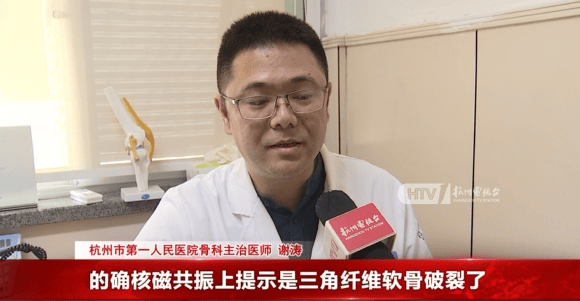In the past two years, cycling has become increasingly popular. However, like any sport, only moderate and correct exercise methods can yield the best results; otherwise, it may harm the body. Recently, a patient was admitted to the Orthopedics Department of Hangzhou First People’s Hospital due to an injury from cycling.
According to the hospital, the patient is 38 years old and has lost 12 pounds in three months of cycling for weight loss. However, she has been feeling pain in her wrist joints, and it hurts more when she grips the handlebars. Gradually, she could not even open a bottle cap or turn her house key.
Orthopedic physician at Hangzhou First People’s Hospital, Xie Tao:
There is a relatively special structure called TFCC, which we refer to as the triangular fibrocartilage. The patient’s MRI indicates that the triangular fibrocartilage is ruptured.
So, where exactly is this TFCC or triangular fibrocartilage located?
Orthopedic physician at Hangzhou First People’s Hospital, Xie Tao:
When we touch our wrist, we actually feel two bones, the ulna and the radius. The radius connects to the wrist, but when you touch the ulna, it feels empty as if there’s no bone; there is a depression there which contains the TFCC triangular fibrocartilage complex.
The doctor explained that the joint connecting the ulna and radius is called the distal radioulnar joint. Including this patient, some women may experience unstable development of the distal radioulnar joint, and repetitive rotational lifting actions can lead to TFCC injuries, requiring stabilization and rest. Currently, this patient’s arm has been put in a cast for fixation.
TFCC injuries often occur among sports enthusiasts, such as during dumbbell presses, playing badminton, tennis, or doing push-ups, which can all potentially cause TFCC injuries. Therefore, the first step in preventing TFCC injuries is to engage in moderate exercise, and wearing protective gear can help protect the joints. If any of the following symptoms occur repeatedly, the doctor suggests seeking medical attention.
Orthopedic physician at Hangzhou First People’s Hospital, Xie Tao:
If you feel pain when twisting a towel or hear a creaking sound when turning your wrist, it indicates instability in the distal radioulnar joint. Additionally, if you can’t support yourself, and feel pain in that area when doing push-ups or when you put weight on your hands, then the distal radioulnar joint might be having issues.
(Source: Hangzhou Comprehensive Channel)


